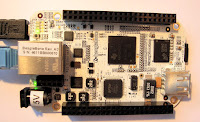A few days ago I found an old friend - an Acorn Microcomputer dating back to the late 1970s. You might know it by its later name of Acorn System 1. It's arguably the great-great-grandfather of Raspberry Pi ( though several orders of magnitude less powerful). Acorn fathered ARM , whose design lies at the heart of RasbPi's processor; the processor is made by Broadcom , who also trace their ancestry back to Acorn. The Acorn Microcomputer has an led display, a keyboard, a 6502 processor, 512 bytes of rom and an amazing 1k of ram. The monitor (a minimalist operating system) lives in rom; programs can be saved and then reloaded using a cassette recorder. It will run off a 9v battery. Somehow I've managed to hang on to its documentation, though you'll find a lot more information, and an emulator, on Mike Colishaw's website . I've done nothing with this early micro for years, and I'd pretty much decided to give it to a museum. I suspect it still works, th...





